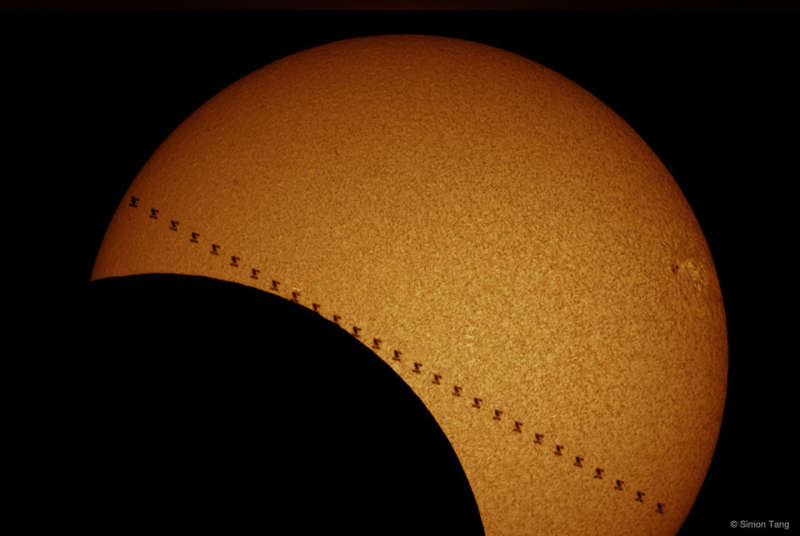Credit & Copyright: Simon Tang
Explanation:
Last week, for a fraction of a second, the Sun was eclipsed twice.
One week ago today, many people in
North America
were treated to a standard, single,
partial solar eclipse.
Fewer people, all congregated along a narrow path, experienced the
eerie daytime darkness of a total solar eclipse.
A dedicated few with fast enough camera equipment, however, were able to capture
a
double eclipse -- a simultaneous partial eclipse of the
Sun by both the
Moon and the
International Space Station (ISS).
The Earth-orbiting
ISS crossed the Sun in less than a second, but to keep
the
ISS from appearing
blurry, exposure times must be less than 1/1000th of a second.
The featured image composite captured the
ISS
multiple times in succession as it zipped across the
face of the Sun.
The picture was taken in a
specific color
emitted by
hydrogen which highlights the
Sun's chromosphere,
a layer hotter and higher up than the usually photographed
photosphere.
Follow APOD on:
Facebook,
Google Plus,
Instagram, or
Twitter
1999 2000 2001 2002 2003 2004 2005 2006 2007 2008 2009 2010 2011 2012 2013 2014 2015 2016 2017 2018 2019 2020 2021 2022 2023 2024 2025 |
Yanvar' Fevral' Mart Aprel' Mai Iyun' Iyul' Avgust Sentyabr' Oktyabr' Noyabr' Dekabr' |
NASA Web Site Statements, Warnings, and Disclaimers
NASA Official: Jay Norris. Specific rights apply.
A service of: LHEA at NASA / GSFC
& Michigan Tech. U.
|
Publikacii s klyuchevymi slovami:
solar eclipse - ISS - Solnechnoe zatmenie - MKS
Publikacii so slovami: solar eclipse - ISS - Solnechnoe zatmenie - MKS | |
Sm. takzhe:
Vse publikacii na tu zhe temu >> | |
